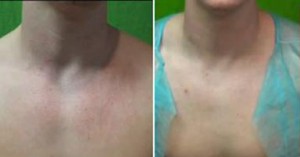Rosacea is a chronic skin disorder that primarily affects the face. It usually begins in individuals in their thirties with redness on the cheeks, forehead, nose and chin. It may also appear on the chest, scalp, ears and neck. Over time, blood vessels in these areas become visible. If not treated, the flushes may turn to pimples and bumps. In more severe cases, excess tissue develops and the nose becomes swollen. The condition is characterized by repetitive flare-ups and remissions.
The National Rosacea estimates 16 million Americans have rosacea. However, a small portion of those affected is getting treatment. Those with fair skin who blush or flush often are thought to be at the greatest risk, but the skin condition can affect anyone. There is no cure for it but medical and cosmetic treatments are available.
SYMPTOMS OF ROSACEA
The appearance of Rosacea differs vastly in individuals but one of the primary symptoms is always apparent. From there, secondary symptoms also develop differently.
- Frequent flushing and blushing
- Continuous redness
- Visible blood vessels
- Pimples and/or bumps
Other potential symptoms and indicators entail itching, burning or stinging of the skin, rough, dry skin, and eye irritation. More severe symptoms include skin thickening, facial swelling and plaques.
Rosacea has four subtypes from mild to severe:
- Erythematotelangiectatic Rosacea: visible blood vessels, flushing and persistent redness
- Papulopustular Rosacea: redness, pimples and bumps
- Phymatous Rosacea: thickening of the skin, possible excess tissue on the nose
- Ocular Rosacea: numerous eye issues, potential vision loss
ROSACEA TREATMENT
Rosacea is a complicated skin condition that requires individual treatment. Always consult with a board certified dermatologist for the best course of action. Topical and oral medications are typically initially used is the condition is minor. They must be continued to keep Rosacea in remission in prevent future outbreaks.
Laser treatment is helpful for moderate to severe cases. It also prevents future outbreaks and alleviates cosmetic issues from the condition. Lasers eradicate the appearance of blood vessels and redness. In more severe cases with excess tissue on the nose, ablative laser treatment and surgery may be required.
Photodynamic therapy such as VBeam is used with Levulan, a topical photosensitizer applied 30 to 45 minutes prior to each therapy. VBeam treatment uses a 585 – 595 nanometer laser to seal off blood vessels, which are eventually absorbed and expelled from the body. It also eliminates redness.
For excess tissue growth, a CO2 laser is used. Fraxel re:repair vaporizes dermis skin for significant resurfacing. The ablative re:pair is only used on light to medium skin tones.
A dermatologist will best advice the course of treatment.

